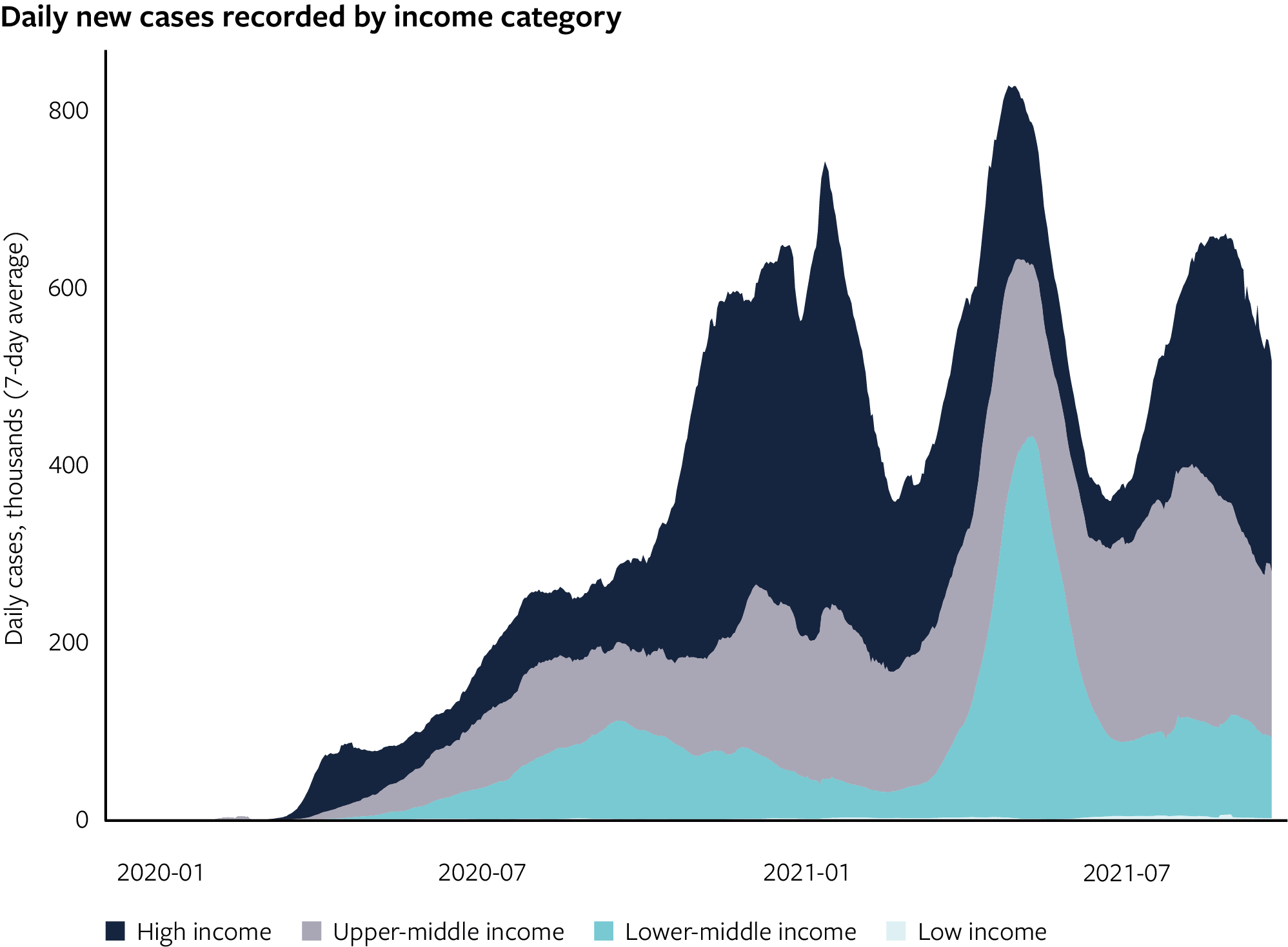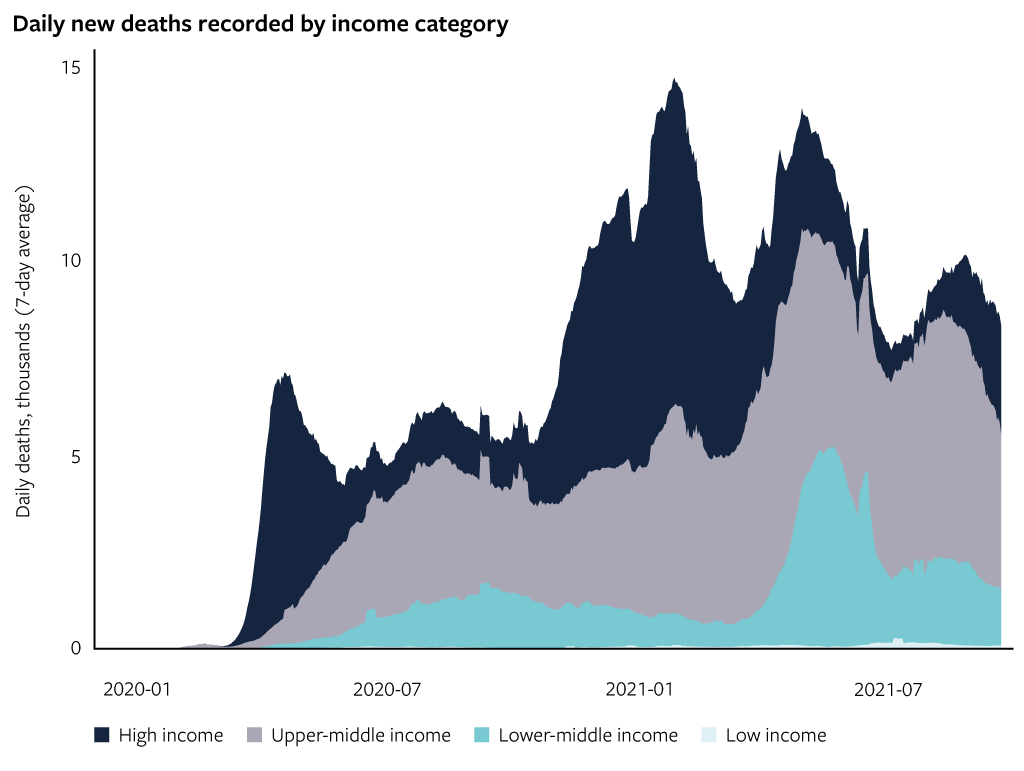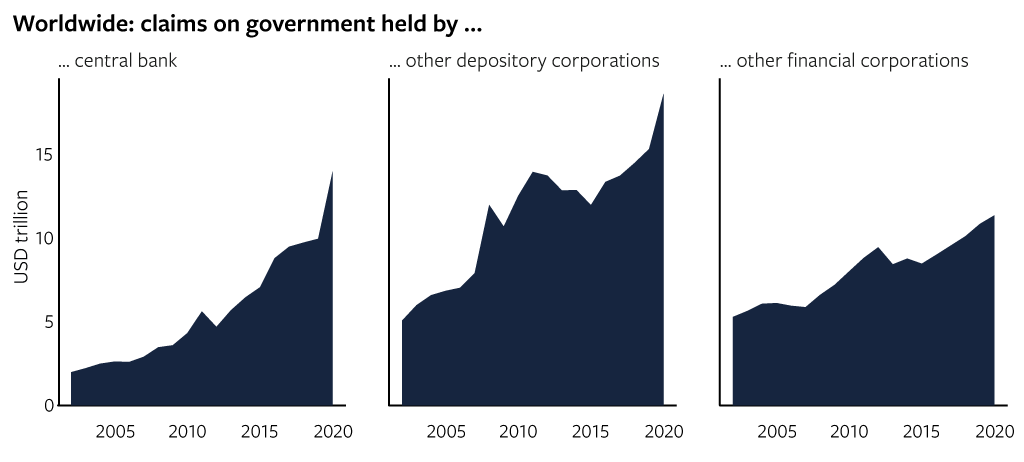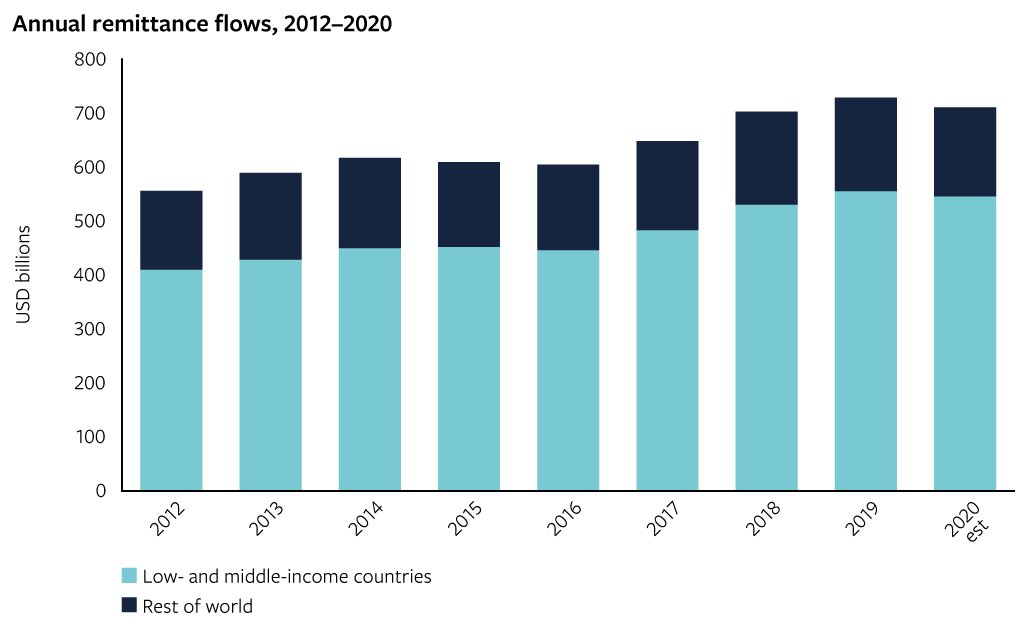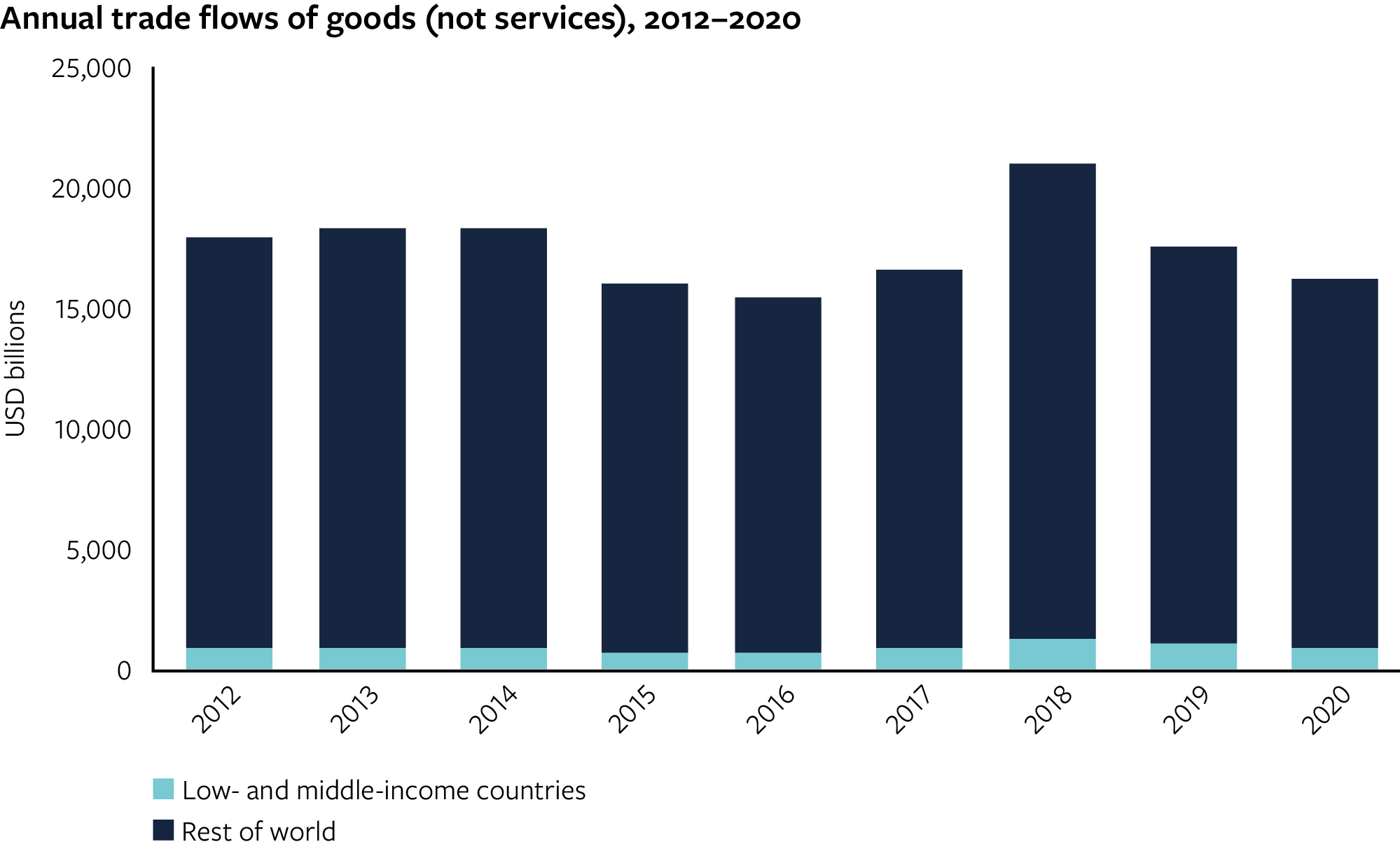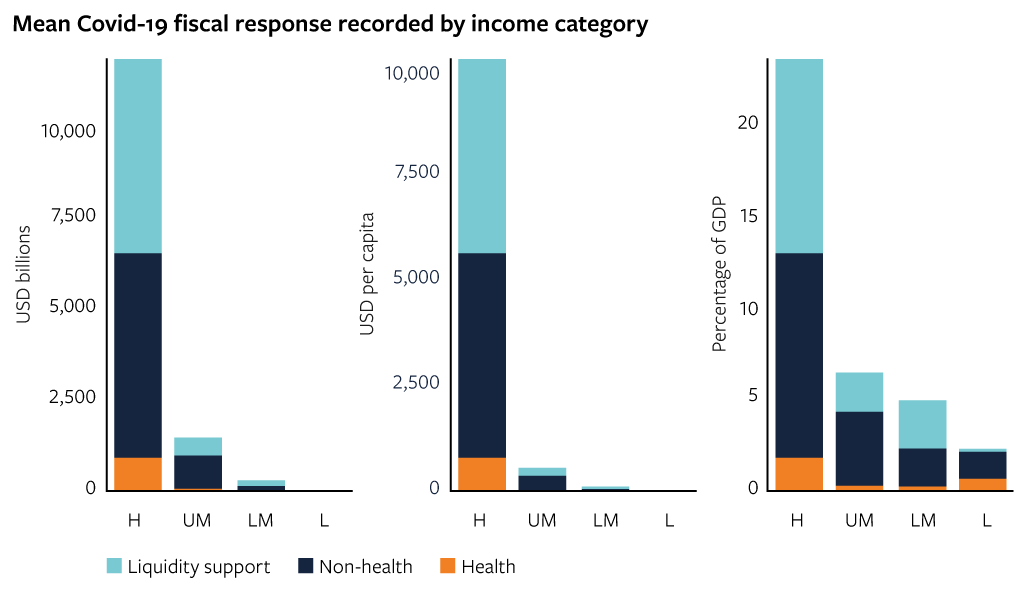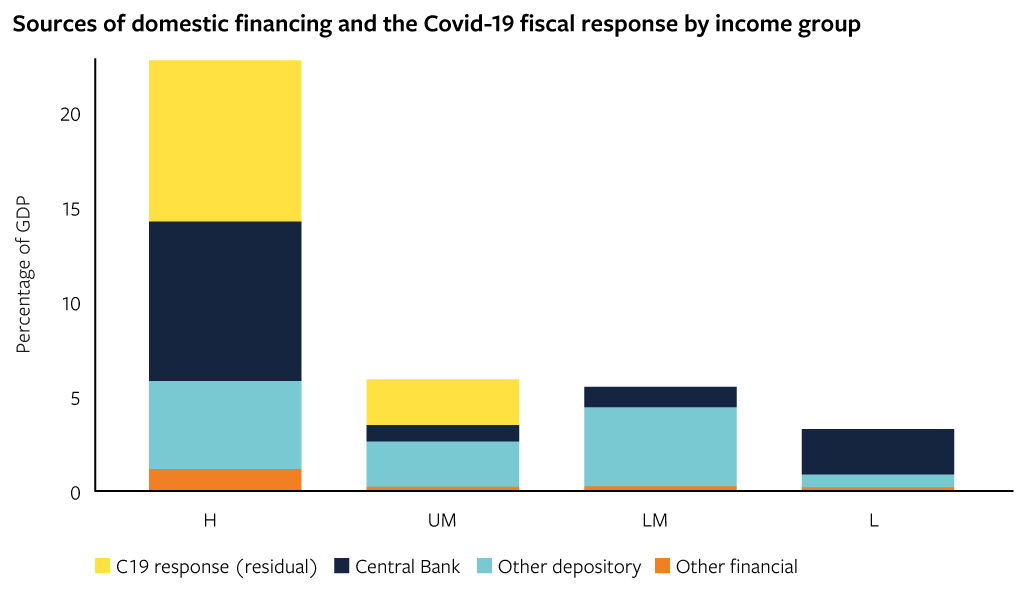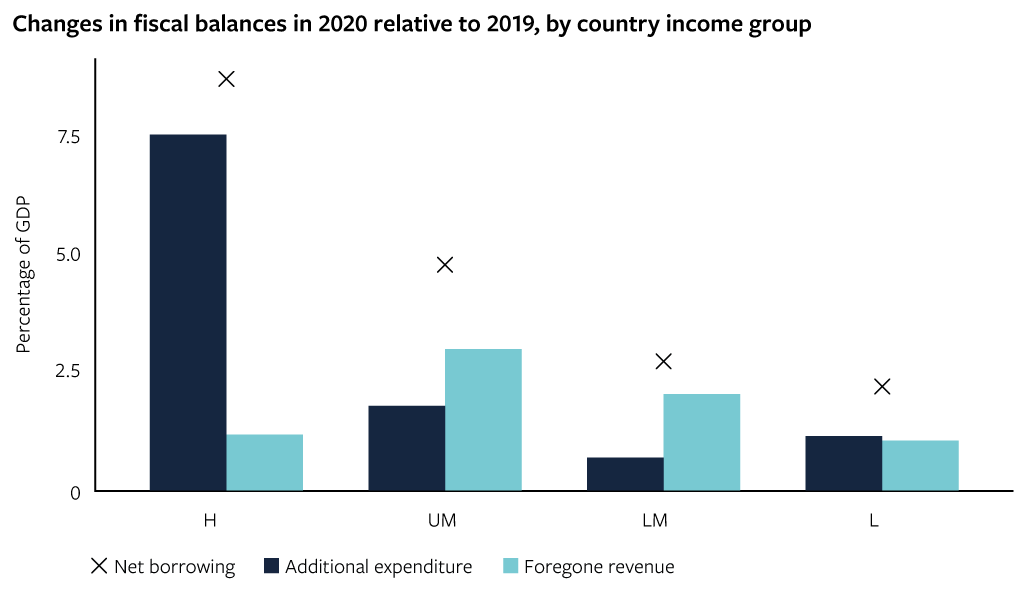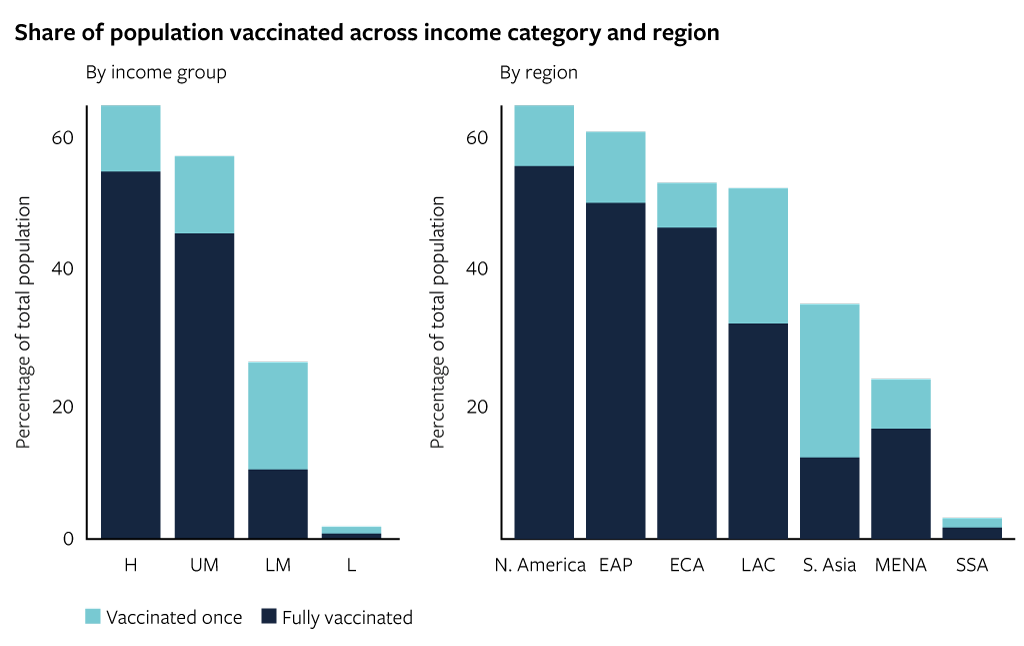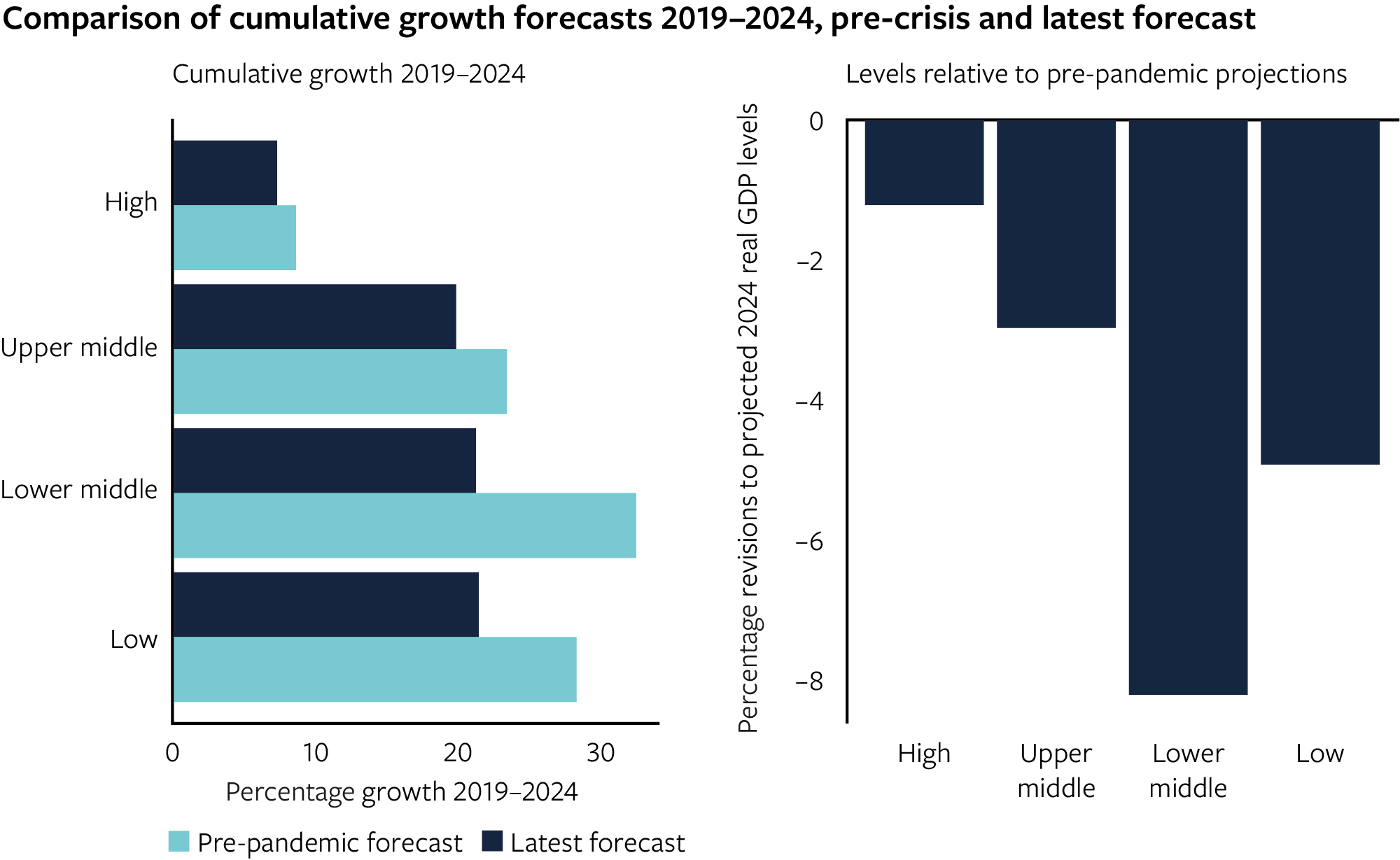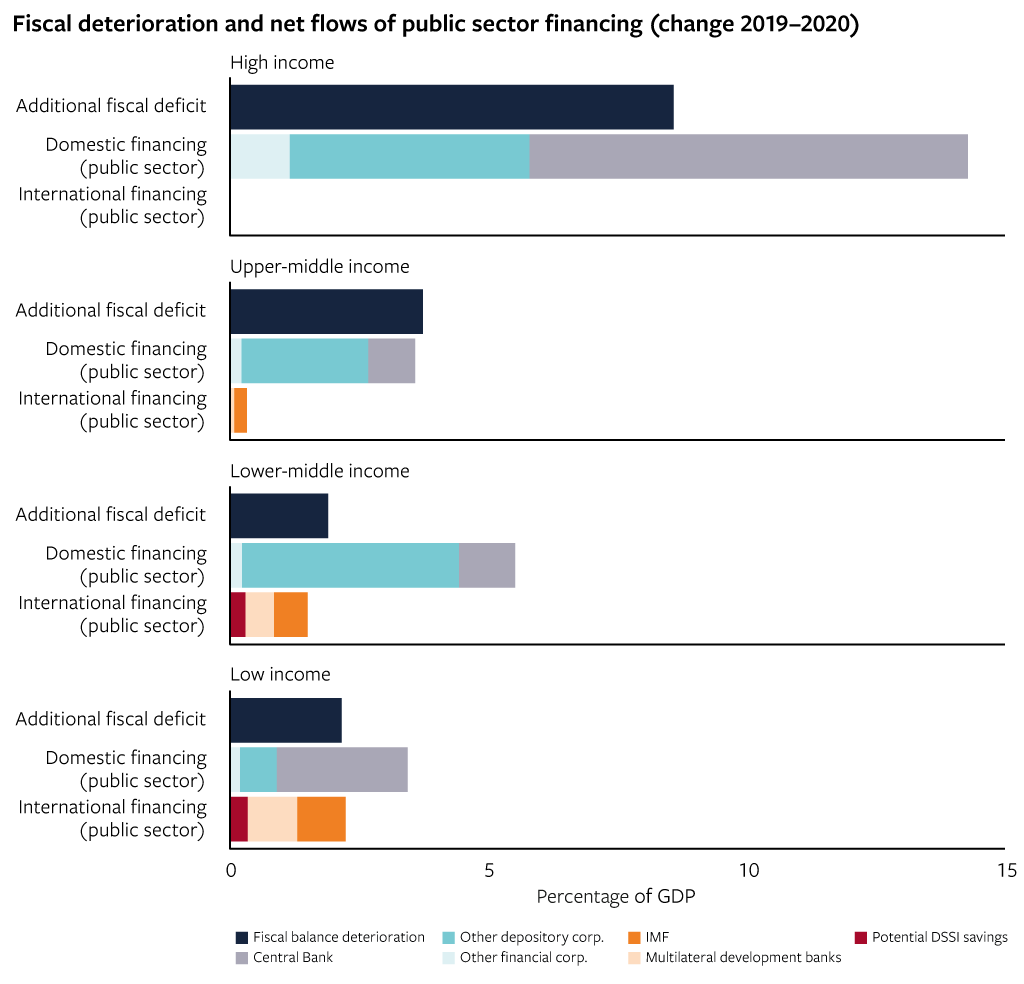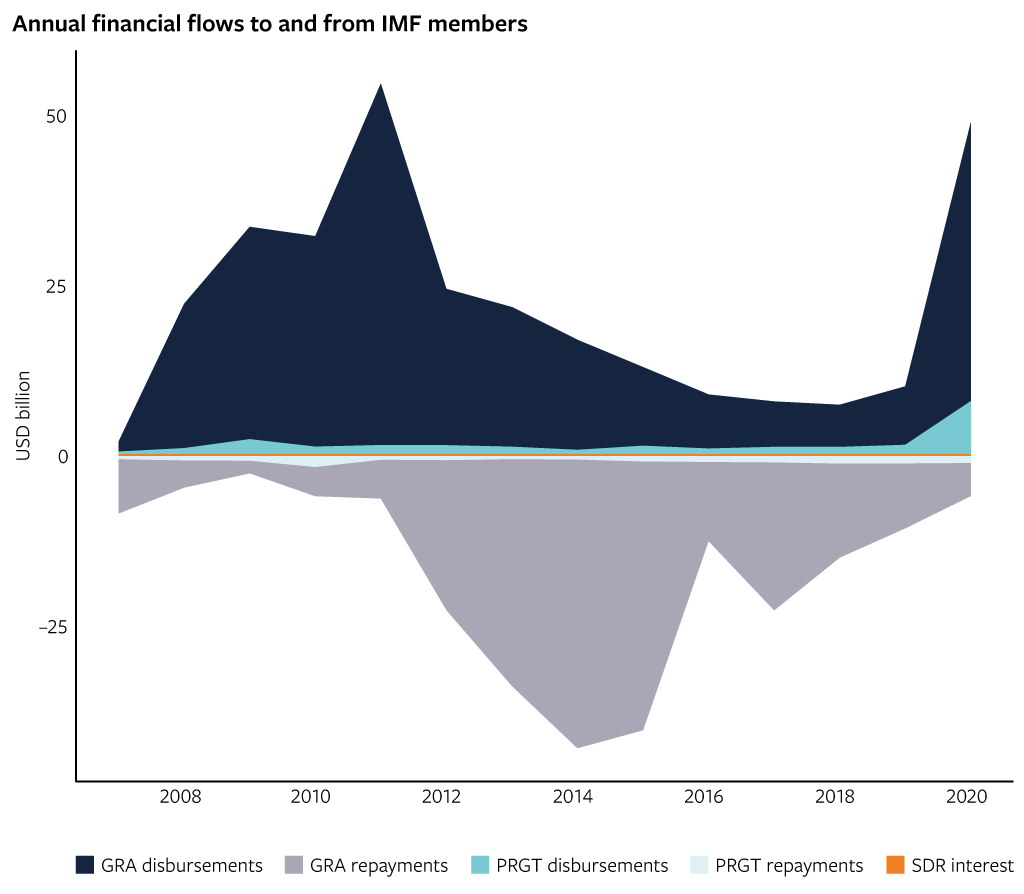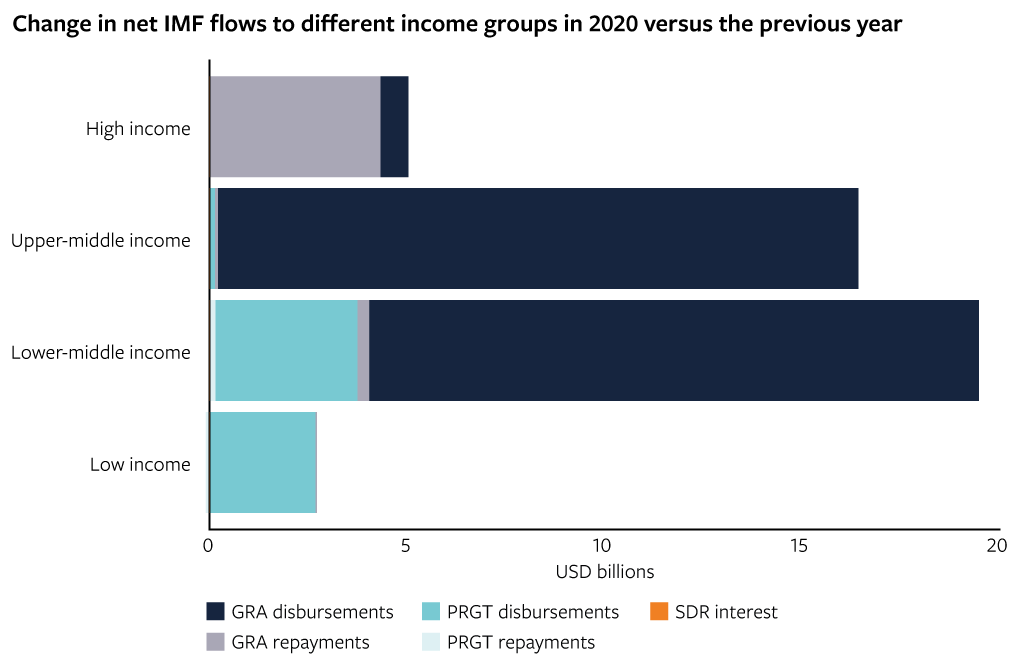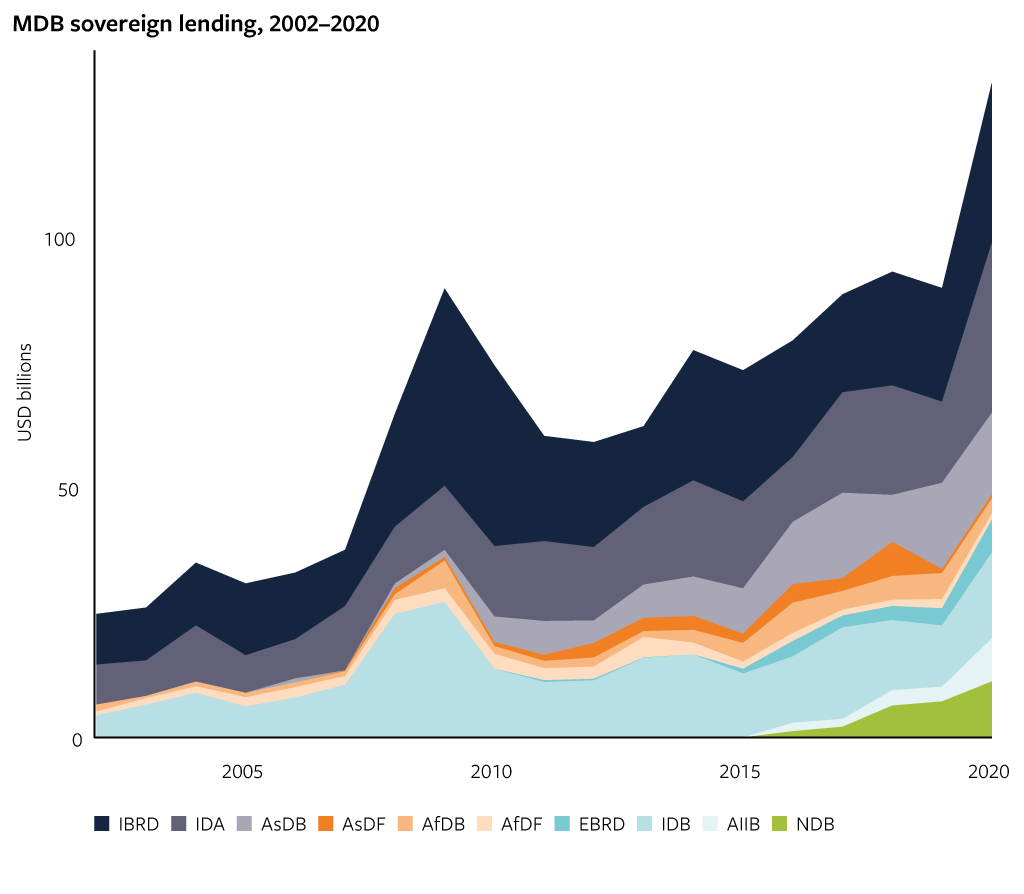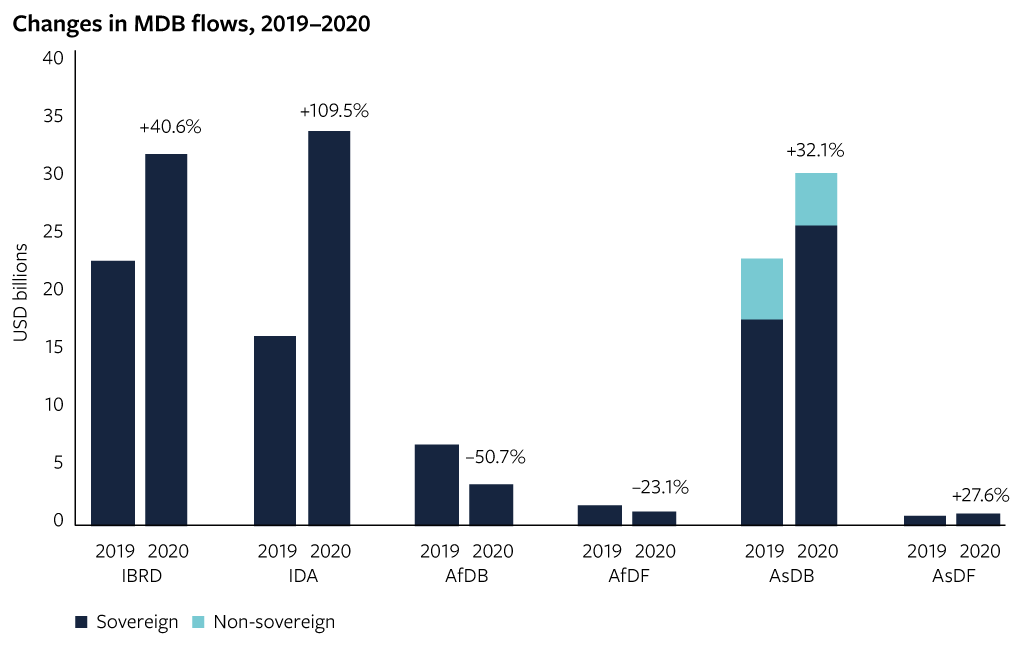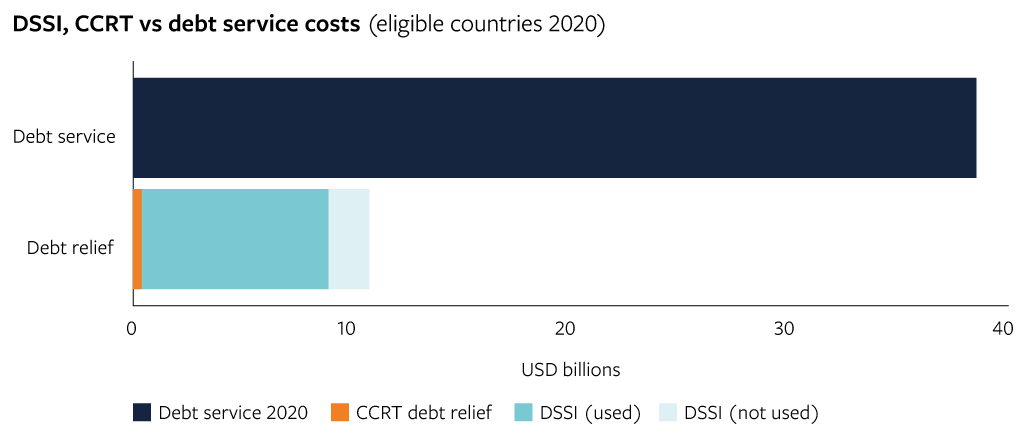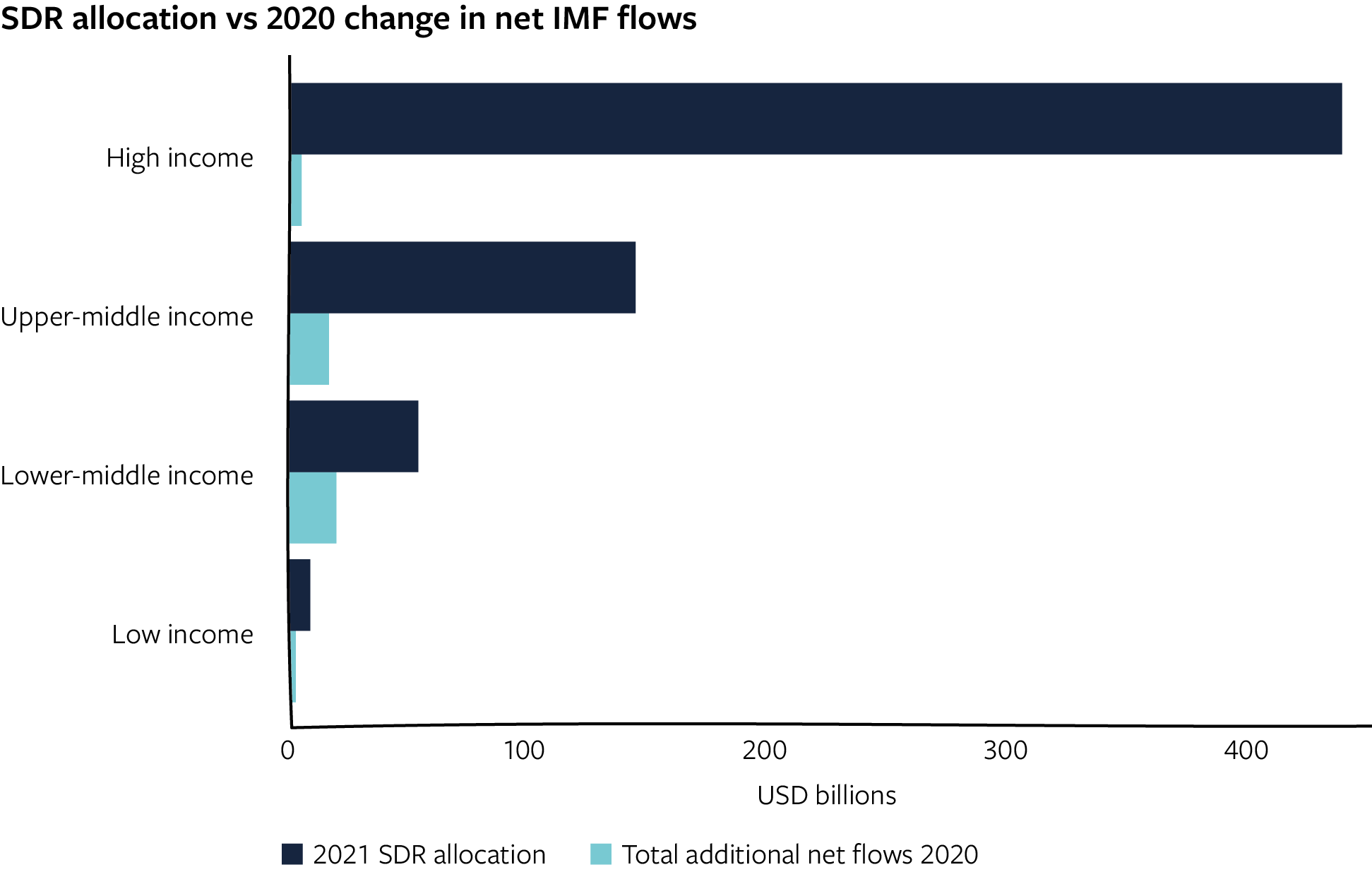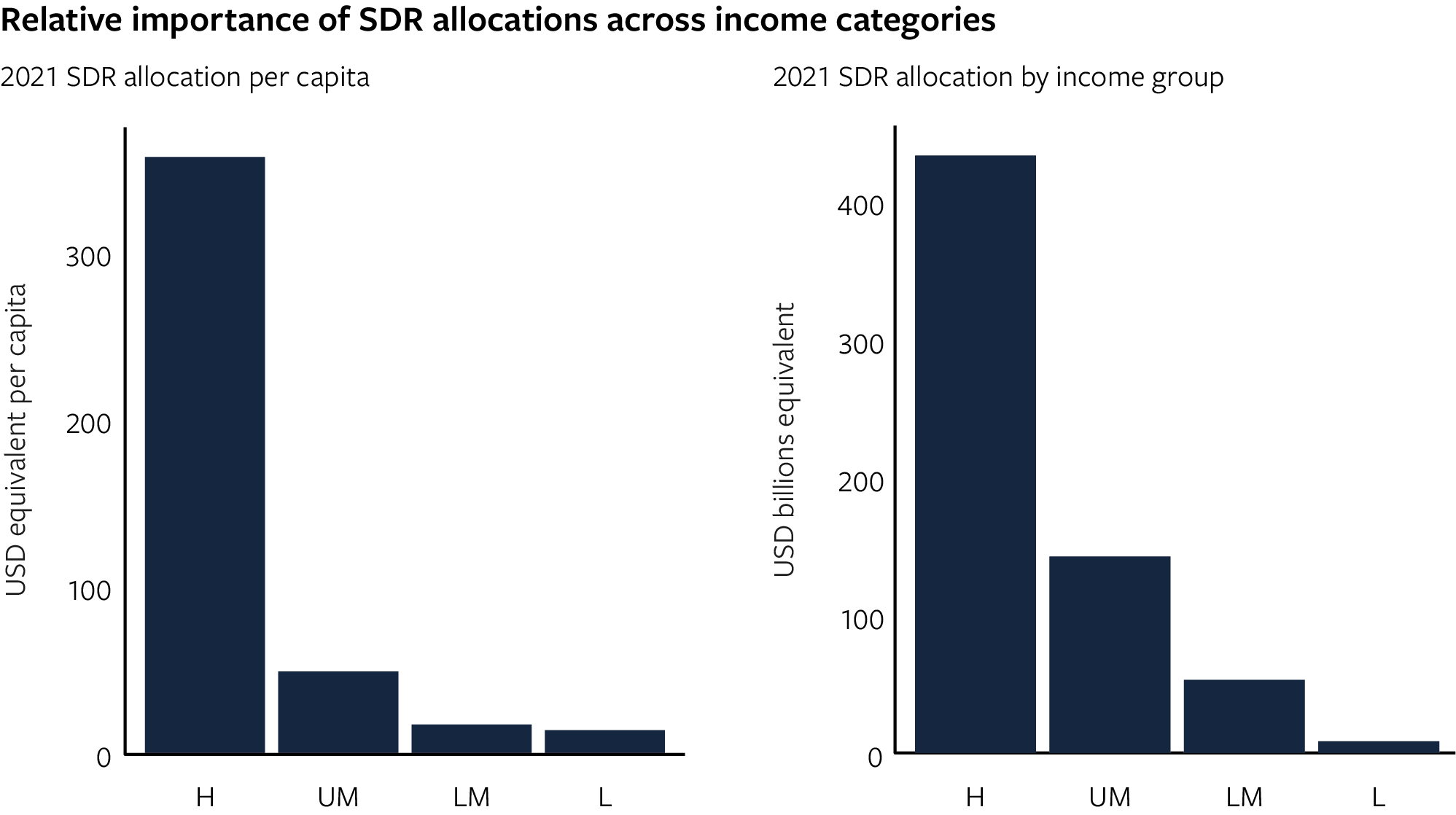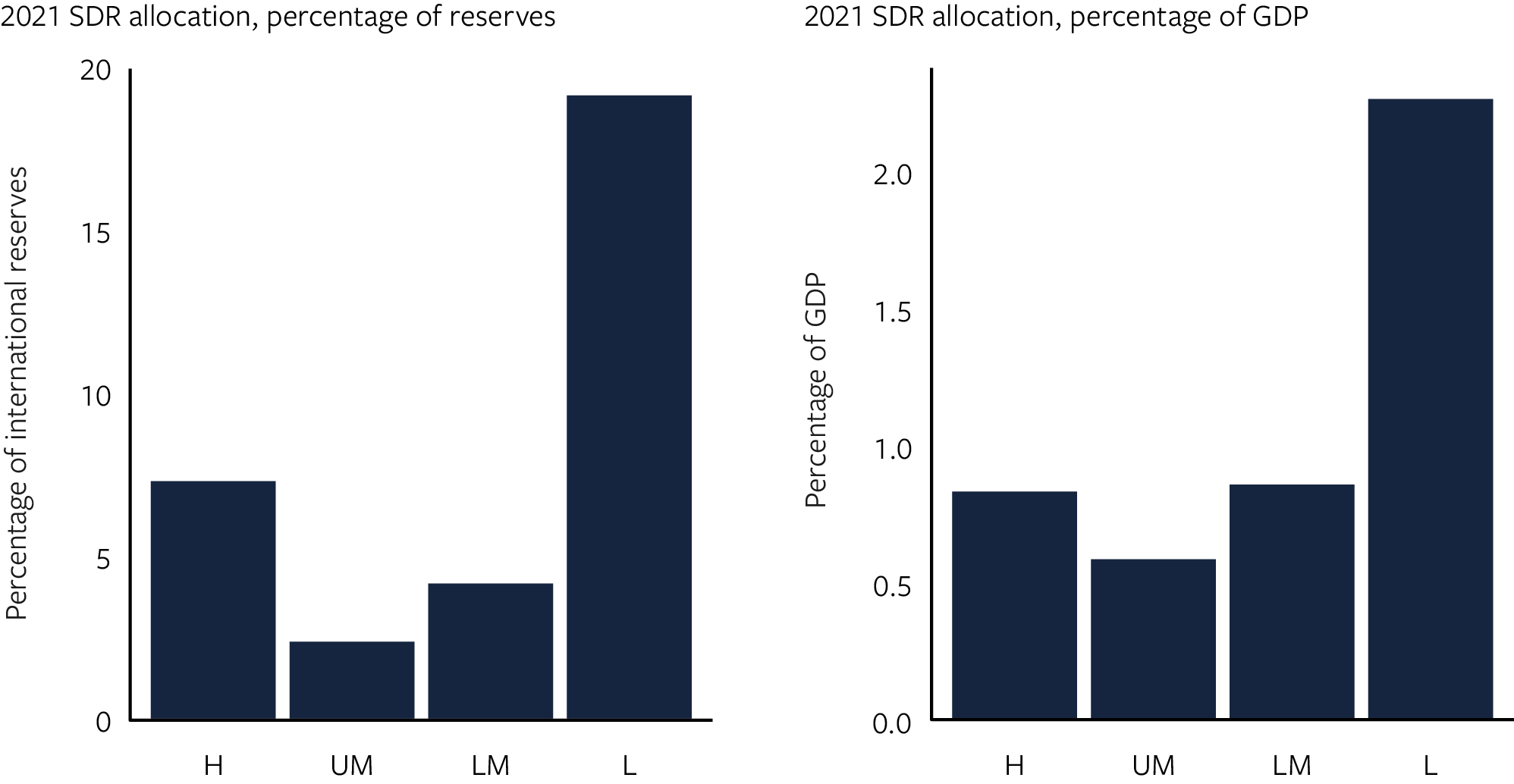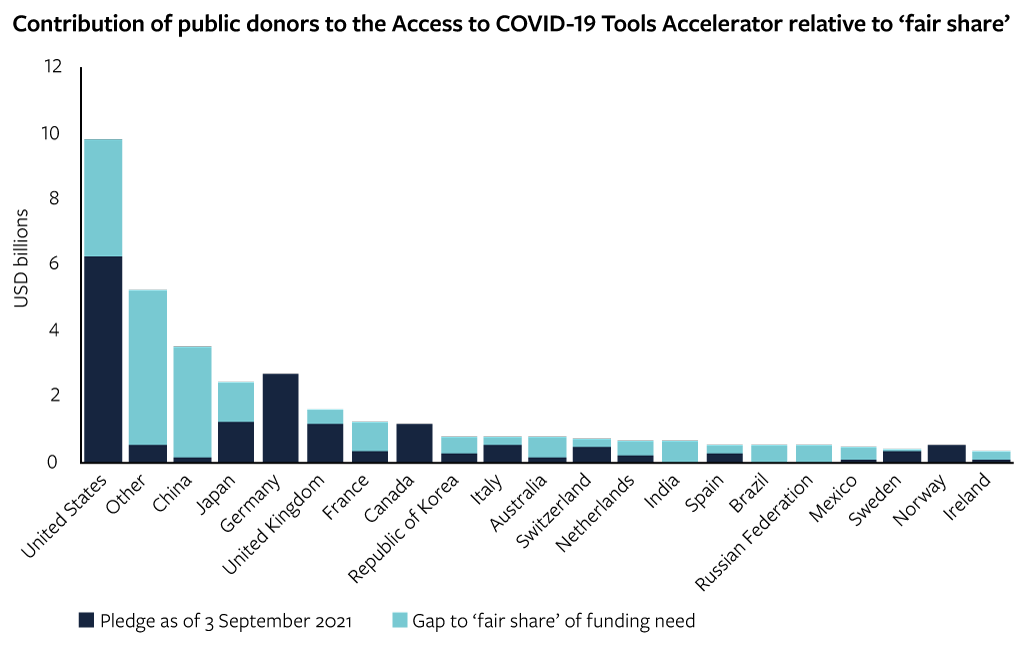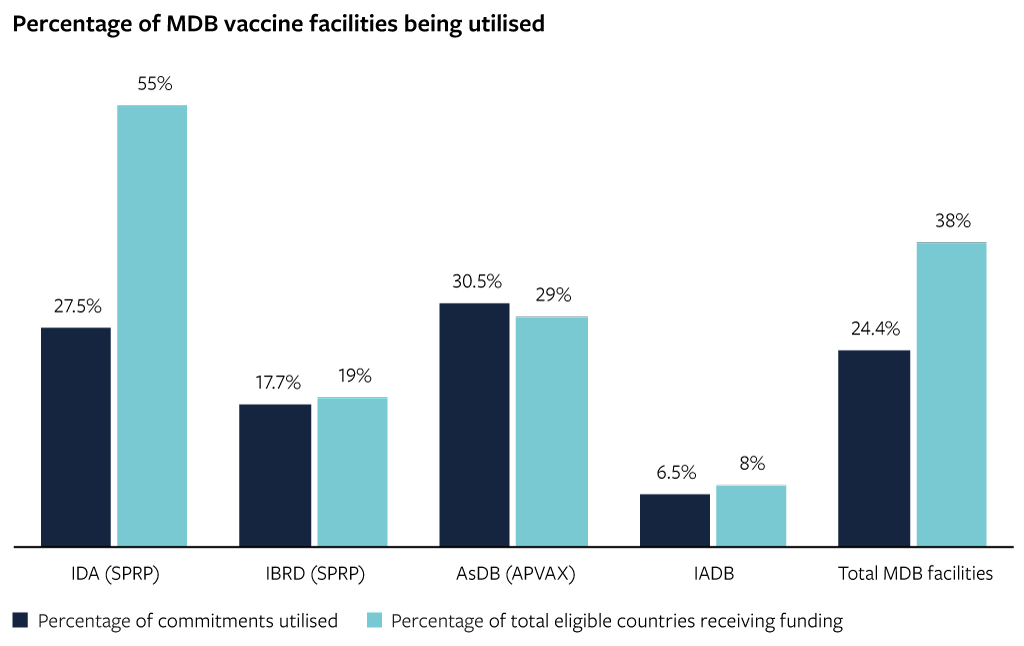Introduction
There is much to celebrate in the way that humanity has managed to counter the threats to life and livelihoods posed by Covid-19. The scientific response to the investment has been outstanding. According to Gavi, the Vaccine Alliance, no fewer than six vaccines have been approved by the World Health Organization (WHO) and 21 vaccines authorised by at least one country. Timely, large-scale economic support packages have also limited some of the lasting global scars from the crisis.
However, the evident inequities emerging across nations pose difficult questions for the structures of multilateralism. Back in early 2020, Covid-19 was a global crisis. While the worst of the health impacts were concentrated in high-income countries, its social and economic impacts were felt around the world as countries fought to contain the pandemic. As of September 2021, it is increasingly a crisis that is separating the world into pockets of vaccinated and unvaccinated nations. In high-income countries, case numbers remain high, but deaths resulting from the virus have fallen sharply (Figure 1). In other parts of the world, the crisis remains ever-present with continued high numbers of daily new deaths (Figure 2) and economies still mired in the challenges of virus containment without vaccines.
Figure 1
Figure 2
This ODI briefing explores how the diverging fortunes across countries have come to pass and the limitations of the multilateral initiatives intended to support a global response. It focuses especially on the multilateral financing measures that have been put in place to combat the crisis and looks at some of the changes that would be required to support a more effective response in future.
The contours of national crisis responses
Back in March 2020, the public health systems in Europe and North America were much less well prepared to prevent a pandemic than previously thought. Hospitals quickly became close to being – and many were – overwhelmed.
Although the worst health impacts were initially concentrated in high-income countries, the economic effects were global. In March 2020, there were sharp outflows of capital as investors sought to sell off risky assets and buy dollars. Governments around the world took measures to contain the spread of the pandemic. Economic activity inevitably shrank as most people were unable to work, travel and provide services due to severe limitations on human contact and movement, often including repeated complete or partial lockdowns.
The central banks and governments of the United States and Europe were much better prepared for the economic response. Drawing on instruments used in the wake of the 2008 global financial crisis, the US Federal Reserve and the world’s leading central banks cooperated to effectively stabilise global financial markets. Interest rates were immediately cut and the US Federal Reserve ‘back-stopped’ major domestic credit markets by reassuring that it would take action to support the functioning of financial markets, including large-scale purchases of corporate bonds and mortgage-backed securities. It also provided international swap lines to various central banks that provide reassurance about the safety of their currencies.
Finance ministers in the US and Europe were quick to follow with huge fiscal policy commitments to protect their populations against the impacts of the pandemic. According to the International Monetary Fund (IMF), national governments announced fiscal policy support measures totalling $13.7 trillion in 2020 alone, equivalent to approximately 16% of global GDP. The fiscal support extended was facilitated by the actions of central banks. In 2020 alone, the government debt held by central banks rose by $4.0 trillion (relative to a rise of $0.7 trillion from 2007–2009) (Figure 3).
Figure 3
More than $1 trillion of investment was used to expand the capacity of health systems to respond to increased demands, including public health. Funds were used to procure protective equipment, oxygen, ventilators and tests, and to develop test, trace and isolate programmes, among other items. The costs of health investments were dwarfed, however, by the relief spending needed to keep economies on ‘life support’. Governments repurposed existing social insurance to extend direct support to many whose livelihoods were threatened by restrictions to economic activity. Monetary and fiscal policies were reshaped to support firms and businesses to weather the economic shock. Globally, governments extended liquidity support in the form of equity injections, loans, asset purchases or debt assumptions to the tune of $365 billion in 2020, guarantees worth $4 trillion, as well as trillions in tax deferrals.
The scientific community had also spent years working on the vaccination technologies that have provided the means through which governments hope they can more permanently escape from the cycle of economic havoc wrought by waves of the virus. In the early months of the crisis, national governments invested substantial public resources into the efforts of scientists and the pharmaceutical industry to develop vaccines at record-breaking speeds (or, in the case of the US, at ‘Warp Speed’). In providing capital for multiple research efforts, governments essentially insured against the risk that not all vaccine developments would succeed and some would fail. The US government alone invested $18 billion in Operation Warp Speed (relative to the $1.4 billion invested through the Coalition for Epidemic Preparedness Innovations).
National responses, global benefits
The global nature of the pandemic meant that the early economic policy decisions taken by governments in high-income countries were closely aligned (if not coordinated) with the needs of governments around the globe. Action by the US Federal Agency to calm and stabilise financial markets served to quickly reverse equity and debt flows from markets in lower- and middle-income countries. This enhanced their room for policy manoeuvre, allowing their central banks to make aggressive cuts to policy rates, ease prudential regulations, and expand the purchase of long-term government securities.
The large fiscal relief packages described above have also helped to sustain aggregate demand in the global economy. For instance, contrary to early forecasts, remittance flows did not collapse and export volumes (of goods, albeit not services like tourism) have also held up better than had been anticipated.
Figure 4
Figure 5
Different countries, different weapons
Despite the strong alignment of global policy needs, the ability of state economic institutions to provide relief to mitigate the impacts of such measures has differed enormously. As Managing Director of the IMF Kristalina Georgieva has put it, ‘for advanced economies, it is whatever it takes. Poorer nations strive for whatever is possible.’ Of the total $13.7 billion deployed in 2020, $11.8 billion (87%) was spent in high-income countries, home to only 16% of the world’s population. As a result, while fiscal support in these countries averaged $10,244 per capita, residents of low-income countries received, on average, less than $15 per capita in government support (Figure 6). There were also major differences in the relative scale of policy packages announced across income groups. Fiscal packages in high-income countries amounted to 23% of GDP, compared to 6%, 5% and 2% in upper-middle, lower-middle and low-income economies respectively.
Figure 6
Figure 7 shows how governments in high-income countries used their central banks to finance the large economic support packages announced. The introduction of these measures translated into significant increases in overall spending and larger fiscal deficits (Figure 8). In lower-income countries, there has not been the same recourse to central bank financing. Fiscal balances have also deteriorated, but deficit financing has been relatively modest and largely used to compensate for declining revenues.
Figure 7
Figure 8
Where governments have had more conservative fiscal responses, this has constrained the scale of income support and social protection measures introduced. Governments have not been able to protect citizens from the impacts of reduced economic activity. The crisis has contributed to the emergence of a ‘new poor’ who according to the World Bank ‘are likely to be more urban and educated than the chronic poor, more engaged in informal services and manufacturing and less in agriculture. Middle-income countries such as India and Nigeria may be home to 75 percent of the new poor.’
As well as differences in the scale of spending on relief programmes, there have also been large differences in the speed with which mass vaccinations programmes have been implemented. In countries where mass vaccinations have been successful, immunisation rates typically exceed 60% of the adult population (Figure 9). In contrast, research indicates that in September 2021, less than 2% of the 680 million people living in low-income countries have received even one dose.
Figure 9
Differences both in the scale of relief and the progress in vaccination are now translating into divergent growth forecasts. This was borne out in the IMF’s April forecasts (and in the more recent partial update), where the US economy was expected to be 0.4% larger in 2024 than projected prior to Covid-19, and the real GDP of high-income countries, on aggregate, projected a decline by only −1.2% compared to pre-crisis projections. In contrast, real GDP projections for that same time frame have been revised downwards by −8.2% and −4.9% in lower-middle and low-income countries, respectively (Figure 10).
Figure 10
A challenging context for multilateral cooperation
Against this backdrop, did multilateral action facilitate relief and recovery in countries with more limited resources upon which to draw? The circumstances for a cooperative response to the crisis have not been propitious. The previous US president shunned international economic cooperation. An initial issuance of Special Drawing Rights (SDRs) was blocked by the former Trump administration, directly motivated by concerns that SDR allocations would benefit China, and potentially Iran and Venezuela. Trump’s withdrawal of funding for the World Health Organization (WHO) also sent a clear signal about US intentions with respect to a global health response. The Chinese government has also preferred to use bilateral channels to supporting vaccines.
Competition between the US and China has also hardened, making it more difficult to offer multilateral approaches to economic cooperation. Historically, China has also preferred to manage any debt restructuring or relief unilaterally. This greatly complicates the type of coordinated action required to offer comprehensive sovereign debt relief where the Covid-19 crisis has placed increased strain on governments with already high levels of indebtedness. It also increases political opposition to provide new lending to governments that may then be used to repay China.
It is not just the ‘great powers’, however, that have constrained greater multilateral intervention. Other G20 nations have not been vocal champions of a global fiscal response that mirrors the unprecedented actions taken at the national level. Indeed, in certain cases (most notably the UK) international assistance has been juxtaposed as directly competing with the resources needed to prioritise domestic relief efforts. This limited ambition to mount an international fiscal response is reflected in aggregate official development assistance (ODA) statistics in 2020, which rose in real terms by 3.5% in 2020 across all Development Assistance Committee (DAC) members. The total increase in ODA was just $8.4 billion, equivalent to 0.06% of the $13.7 trillion of all the national government fiscal measures to address the pandemic.
The multilateral economic response
Nevertheless, in April 2020, the G20’s finance ministers did commit to certain measures to counter the economic impacts of the crisis, some of which have helped to increase the volumes of international finance available to sovereign governments, particularly in lower-middle-income and low-income countries that tend to be more reliant upon concessional sources of external finance. Figure 11 shows that, on average, net international flows to low income and lower-middle-income countries increased by 1.5% and 2.1% of GDP in 2020 relative to the previous year, respectively. In aggregate, the increased flows of international finance appear to have been ‘absorbed’ (and not simply saved to bolster reserves) reflected by equivalent increases in fiscal deficits (although this clearly masks significant variation across countries).
Figure 11
In 2020, for want of alternatives, IMF lending was the most important source of additional finance for these countries. The IMF increased its net lending by $44 billion more than the previous year (Figure 12). In terms of scale, this is close to the peak levels of lending after the global financial crisis, but very different from the IMF’s lending capacity of $1 trillion that was being touted at the start of the crisis. While lending after the financial crisis was dominated by efforts to preserve the euro (and by extension the stability of the global financial system), IMF support in response to Covid-19 has been focused on providing emergency relief loans to lower- and middle-income countries (Figure 13). This is reflected in the sharp rise of IMF lending through the Poverty Reduction and Growth Trust (PRGT) fund, which targets the poorest and most vulnerable economies and which rose sharply even if the overall volumes of lending were small.
The scale of IMF finance is tightly connected to its lending rules: in any given country, the volume of lending is linked to its IMF quota and confidence in the sovereign’s ability to repay. Emergency loans made from the IMF are designed to help address ‘urgent balance of payments needs’. For instance, the maturity of loans that were provided through the IMF’s general resource account is short: loans need to be repaid within a maximum of five years. Those who live in countries with already high levels of indebtedness (for instance Zambia) also do not stand to benefit. In essence, IMF financing instruments were designed to help meet temporary liquidity needs, they were not set up to help fairly share the burden of responding to global crises.
Figure 12
Figure 13
During the course of 2020, the major multilateral development banks (MDBs) also increased their overall lending volumes. According to data on project approvals, total lending from the largest MDBs reached $131 billion in 2020, up from $90 billion in 2019. In overall volume terms, this is higher than the loans provided in 2009 in the wake of the financial crisis (although these figures also reflect $10 billion of new lending from the Asian Infrastructure Investment Bank and the New Development Bank that were set up after the global financial crisis). Although overall lending volumes increased, Figure 14 shows that there was a much sharper rise in proportional terms in overall year-on-year lending in the wake of the global financial crisis.
Figure 14
At the World Bank in particular, much of the increase in lending volumes has also come through a rise in lending through the concessional lending window, the International Development Association (IDA). The concessional lending window targets the poorest and most vulnerable countries and in certain cases offers a mix of grants and loans (depending upon projections of debt sustainability). In contrast to the global financial crisis, increases in non-concessional lending that targets middle income countries have been more muted. This is even though many of the ‘new poor’ have emerged in middle income countries. Overall lending volumes have fallen significantly short of the early commitments made [PDF].
Figure 15
As well as new lending, G20 governments also agreed on a temporary suspension of sovereign debt-servicing payments. In 2020, the 73 countries deemed eligible for the Debt Service Suspension Initiative (DSSI) faced costs of debt service close to $40 billion across different creditors, according to the World Bank. Despite the initial ambition for ‘all creditors to be involved’, ultimately only debt-service payments to official bilateral creditors were suspended. Multilateral creditors offered limited debt relief on their own terms (such as the IMF through the Catastrophe Containment Relief Trust), while private creditors were spared altogether. Not all eligible countries agreed to participate, fearing that a debt moratorium from private-sector creditors would adversely affect their credit ratings and market access. This limited participation has meant that less than $10 billion of debt servicing has been suspended (although there have been further gains through a decline in borrowing costs).
Figure 16
The DSSI was also designed as a temporary instrument and is currently scheduled to close at the end of 2021. As such, the DSSI only postponed payments (it is ‘net present value neutral’) – it did not offer any lasting debt relief. In November 2020, G20 governments agreed to ‘a common framework for debt treatments beyond the DSSI’, which is intended to ensure comparable treatment across all creditors. However, it relies on debtor countries requesting treatment (and facing the associated risks of losing access to bond markets), while the potential benefits remain unclear. To date only three countries (Chad, Ethiopia, and Zambia) have applied for relief through the framework and no treatment has been concluded.
In August 2021, a $650 billion issuance of SDRs came into effect. Relative to the initial crisis lending response, the scale of the SDR issuance is huge. This is true across all country income groups including the lowest-income countries, who were issued $8.6 billion of new SDRs, compared to $2.6 billion of additional IMF lending in 2020.
Governments are able to exchange their SDR reserves for freely convertible hard currencies at an ongoing cost that is linked to the SDR interest rate (currently just 0.05%). Importantly, unlike loans from international financial institutions (IFIs) or bilateral creditors, they do not require repayment. SDRs can be used to pay off other more expensive debts incurred to different creditors (the IMF, MDBs, private-sector creditors, the Chinese government), thereby reducing overall debt-servicing costs.
Figure 17
Special Drawing Rights are issued according to IMF members’ quota shares, meaning that these are not based on need. On a per capita basis, the increase is greater in the highest-income countries who least need the additional liquidity (equivalent to $363 per capita in high-income countries and $15 in low-income countries). Nevertheless, as Figure 18 shows, when the SDR issuance is compared against key macroeconomic variables, it is clear that it has much greater economic significance in low-income countries. It is of much less economic significance in lower- and upper-middle-income countries.
Figure 18
Multilateral financing of the health response
While national investment proved effective in developing effective vaccines, multilateral efforts to achieve a fair distribution of vaccines have patently struggled. The WHO Access to Covid-19 Tools Accelerator (ACT-Accelerator) was designed as a mechanism to ensure equitable access to Covid-19 tests, treatments and vaccines. Although it has now raised nearly $10 billion since its inception, it has been hampered by the slow funding response from the largest economies and remains under-funded (Figure 19).
High-income countries bought up most of the early global supply of vaccines as the ACT-Accelerator was still raising funds. COVAX, the vaccine arm of the ACT-Accelerator, has access to around 1.4 billion doses of vaccine in 2021, well below the initial target of 2 billion. COVAX’s over-reliance on one supplier, the Serum Institute of India, meant that when India’s second wave in early 2021 led to the introduction of export bans on its vaccines, COVAX faced severe supply shortages.
Figure 19
In contrast to COVAX, the MDBs have had significant funding at their disposal. By mid-2020, MDBs had announced $30 billion for purchase and deployment of Covid-19 vaccines. The World Bank has set aside a total of $20 billion until the end of 2022 for the acquisition and deployment of vaccines (as part of the Covid-19 Strategic Preparedness and Response Program, or SPRP), with funding equally split between the concessional window (IDA) and non-concessional window (IBRD). The Asian Development Bank (ADB) established a $9 billion Asia Pacific Vaccine Access Facility (APVAX), and the Inter-American Development Bank (IADB) a $1 billion facility. These amounts are equivalent to 34% of their combined annual average lending portfolio between 2017/18 and 2019/20. However, as shown in Figure 20, MDB resources for vaccine coverage are underused by eligible countries.
Figure 20
What explains this underuse? Governments may have been reluctant to finance additional vaccine coverage from borrowing, given that conventional fiscal wisdom discourages borrowing for ‘recurrent expenditure’ – which accounts for a large proportion of public spending on education, health and social protection – as the returns from such expenditures cannot readily translate into loan amortisation. This will also constrain expenditure on vaccine purchases, as this would also be classified as recurrent expenditure. A reluctance to borrow to finance vaccines may also have been exacerbated by an initial underestimation of the consequences of the crisis. The first wave of the pandemic left many lower- and middle-income countries relatively unscathed compared to Europe and the United States.
The simplest explanation, however, for why countries are not demanding finance from the MDBs is that there are no eligible vaccines to purchase. According to the Duke Global Health Innovation Center, nearly all of the 2021 manufacturing of eligible vaccines has already been purchased (with the exception of the Chinese-manufactured Sinopharm and Sinovac vaccines, whose efficacy against the Delta variant is less clear).
Where governments have provided financial support to COVAX, they have at the same time undermined its stated aims by using their financial clout and manufacturing capabilities to secure their own economic and health interests before and above those countries served through COVAX. In addition, some of these very governments are not accepting vaccines financed through COVAX as proof of vaccination status. For instance, the UK is not accepting vaccine certificates from only limited countries outside of the US and EU.
What comes next?
1/ The immediate crisis response
The key immediate risk to a more inclusive, global recovery remains multi-speed vaccination programmes. Governments of rich countries are continuing to make welcome bilateral commitments to donate vaccines. At the most recent United Nations General Assembly, the US pledged to donate an additional 500 million doses of the Pfizer vaccine. Japan, France and Italy have also all increased commitments to donate vaccines in recent weeks. However, it is clearly almost impossible for a government to plan a comprehensive mass-vaccination programme based upon an unpredictable stream of donations.
Yet a cooperative international plan that sets out a collective commitment to enable a full, global escape from the Covid-19 pandemic remains elusive. There is no global response roadmap, no global commitment to share technology and know-how and no clear multi-year collective financing commitments.
On the economic front, attention is shifting to whether more can be done to maximise the impact of the recent issuance of SDRs. In June 2021, the G7 agreed in principle to channel $100 billion of the SDR allocation towards countries worst affected by the crisis. Reallocated SDRs will likely look different to ‘domestically owned’ SDRs. Recycled SDRs will almost certainly be channelled through intermediaries as part of conditional arrangements between a multilateral organisation and a recipient government with associated repayment terms and conditions of use. To date, there are also no concrete commitments that will translate into additional resource transfers in the short term.
The most obvious vehicle for reallocating SDRs is the IMF’s PRGT, as there is already a track record of higher-income countries ‘on-lending’ SDRs through this mechanism. However, committing to reallocate SDRs through the IMF’s PRGT (in its current form) is unlikely to have any short-term impact on the volumes of IMF lending. Over the next 2–3 years, lending through the PRGT will be primarily constrained by the ability of recipient countries to absorb and repay loans rather than the volumes of immediately available finance. Table 1 shows that at the end of June 2021, the IMF already had commitments of close to 13.5 billion SDRs that had not been lent (see Table 1). Under the IMF’s current baseline lending scenario, any new lines of SDR credit will only be lent out after 2024. Commitments to recycle SDRs to the IMF PRGT will help the long-term financial sustainability of the IMF PRGT, but they will not be a game changer in terms of the amounts that the IMF lends over the next 2–3 years.
Table 1: Outstanding loans to the PRGT at end June 2021
| Lender | Existing lending limit to the PRGT | Monies already lent through the PRGT | Amounts outstanding |
|---|---|---|---|
| Australia | 500 | 211 | 289 |
| Belgium | 700 | 24 | 676 |
| China | 1,000 | – | 1,000 |
| Denmark | 300 | – | 300 |
| France | 4,000 | 661 | 3,339 |
| Germany | 3,000 | 581 | 2,419 |
| Italy | 1,000 | – | 1,000 |
| The Netherlands | 500 | – | 500 |
| Norway | 400 | – | 400 |
| Sweden | 500 | – | 500 |
| Switzerland | 500 | – | 500 |
| United Kingdom | 4,000 | 1,393 | 2,607 |
| Total | 16,400 | 2,869 | 13,531 |
In the short term, the reallocation of SDRs will only translate into increased net flows of finance if other more concessional vehicles for recycling SDRs are identified. One possibility being considered is a new IMF lending facility focused on resilience and sustainability that would offer more concessional terms and potentially be available to more countries. John Hicklin shows why such an instrument conveys ‘several advantages’ over other vehicles for recycling SDRs especially with respect to addressing the limited risk appetite of potential donor countries. Working through the IMF allows for mechanisms where SDRs can be reallocated, but then quickly called back if needed. There are however also some limitations: for a start, it will still take time to set up such an instrument. Absent significant commitments to subsidise the fund, there will also continue to be limits to the concessionality of finance offered.
SDRs could also conceivably be recycled through the multilateral development banks, which are also ‘prescribed holders of SDRs’. MDBs have existing lending instruments that could be used to quickly upscale the volumes of finance provided either through their concessional or non-concessional windows. Channelling SDRs through the MDBs entails additional complexity relative to working through the IMF and would require deep cooperation between the IMF and MDBs to think through the practicalities. MDBs lend monies in hard currency (not SDRs) and would not be able to manage the ‘reserve asset’ status of the SDR in the same way.
Fundamentally, the utility of SDR recycling will depend on the amounts of risk that donor governments are willing to absorb. Governments around the globe have benefitted from a global issuance of SDRs, but if there is not a willingness to cede significant control over those increased reserves, then the impacts of the overall issuance will be much more muted.
There is also the continued challenge of large debt overhangs in many countries, which will limit the room for post-crisis investment. Debt may be assessed as being ‘sustainable’ in as far as countries can repay it, but the costs of servicing that debt will weigh heavily on prospects for recovery. Clear commitments from China and the shareholders of multilateral creditors would seem to be a prerequisite for providing deeper and more comprehensive debt relief for countries that need it. The rising wider concerns about the overall levels of indebtedness in China’s economy makes a Chinese-led far-reaching commitment to debt relief look unlikely.
2/ Building a more agile and adaptive multilateral system
The specific challenges posed by the Covid-19 crisis have demanded that bureaucracies across the world adapt and innovate to respond to the specific challenges it has posed. Unfortunately, the crisis has often exposed the rigidity in the operations and instruments of multilateral organisations.
In terms of the economy, the IMF was quick to provide financing programmes, yet its fixed lending instruments have limited the scale and coverage of its financing support. Eighteen months into the crisis, there also appears to be limited urgency in creating a newly touted window to expand the coverage of its concessional lending.
The MDBs have also been loath to depart too far from business as usual. ODI’s Chris Humphrey shows that there has seemingly been an unwillingness to countenance changes in the conservative risk management practices that could enable much greater volumes of lending through the non-concessional windows to support post-crisis recovery. There has also been limited adaptation of instruments towards the specific challenges of the crisis. For instance, Clemence Landers and Rakan Aboneeaj have shown how 70% of World Bank budget support operations incorporate long-term policy reforms instead of short-term crisis-focused measures.
A slowness to adapt instruments has been even more evident in relation to the financing of vaccines, where there has been a mismatch between how funds have been made available, and where they are needed. The result is that there have been MDB funds sitting idle at the same time that COVAX has been short of funding. This has revealed the problems of a country-based lending model when trying to finance purchases of a quasi-global public good.
These problems are now being resolved, but a year too late, and at a time when the pandemic is still claiming lives in unvaccinated populations in many lower- and middle-income countries (and, indeed, in high-income countries). The new financing facility set up by the World Bank and COVAX in July 2021 now allows COVAX to make advance purchases from vaccine manufacturers using financing from the World Bank and other MDBs beyond donor-subsidised vaccines. This will help link governments’ demand for vaccines and their IFI financing. The World Bank has also agreed with the African Union that its funds can be used to finance vaccines purchased under its pooled African Vaccine Acquisition Trust (AVAT).
Multilateral actors have a role to play in the ideas they champion as well as the finance they provide. Here the IMF’s dual role as an international authority on macroeconomics and its role as a lender has come into tension. The IMF repeatedly urged governments ‘to do whatever it takes’ to counter the crisis encouraging the use of fiscal policy to provide relief and stimulate recovery. At the same time however, the lending programmes agreed between the IMF and recipient countries initially required 72 countries to start fiscal consolidation measures as early as 2021. One could interpret these documents as implying ‘do whatever it takes, so long as we are repaid’. These tensions are only likely to grow as the coverage of IMF lending potentially expands.
3/ Building national support for addressing global problems
In the medium term the crisis raises more fundamental questions about multilateralism. High-income countries have brought together financial, fiscal and industrial policy to enable what they hope will offer them a longer-term escape from the pandemic. The response has provided a reminder of the potential power of nation states to address seemingly intractable problems. Although consensus is fraying about the continued role of fiscal policy, it has also likely retired any notion that macroeconomic management can largely be left to central bankers alone.
In contrast at the international level, the policy response has almost entirely relied upon increasing the amounts of international credit made available. There has been no correspondingly large international fiscal response through increases in the provision of international public finance. The effectiveness of the global response to the pandemic has been enormously constrained by the unwillingness to commit increased public spending to international policy objectives. The gains from national industrial policy and investments in vaccines have also been hoarded by individual nations. There remains an unwillingness to share the knowledge and know-how required to develop vaccines.
The post-1945 economic reconstruction, the effort to mount a global response to HIV and AIDS, and the setting up of Gavi, the Vaccine Alliance, all offered precedents for action beyond national borders for the greater good. That this has not happened reflects, perhaps, a decline in global political ambition; whatever the cause, it signals a poorer common future. A world that can impose border controls on refugees from war and environmental catastrophe, but cannot come together to address the health and economic fallout of a global pandemic, is not one that can hope to resolve global challenges to the future of ‘our common planet’.
